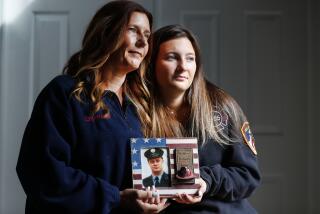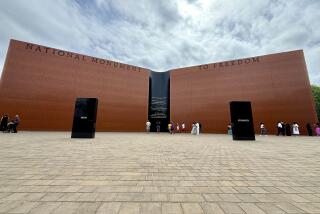Memorial Dedicated Amid Tears, Joy
WASHINGTON â Fifty-nine years after World War II ended with Germanyâs collapse and Japanâs surrender, the United States paid its public respects Saturday to the soldiers who fought the war abroad and the women and children who sacrificed food and comfort to support them at home.
The National World War II Memorial, formally dedicated in solemn ceremonies on the Mall, was born in controversy. Preservationists railed against interrupting the vista between the Washington Monument and the Lincoln Memorial. Architecture critics scorned the design, calling it imperial, childish and worse. Congress balked at paying for it.
But on Saturday, with a pleasant breeze and temperatures in the mid-70s, veterans and their families flocked to Washington by the tens of thousands to deliver a resoundingly positive verdict. Some in wheelchairs, others supported by family and friends. Many dressed in respectful blazers but more casual, sensible shoes.
And often there were tears in their eyes as they listened to President Bush, former Kansas Sen. Bob Dole and others describe what veteransâ sacrifices meant to America.
âThese were the modest sons of a peaceful country, and millions of us are very proud to call them âDad,â â Bush said, with his father, former President George H.W. Bush, sitting behind him on the dais, along with former President Clinton. âThey gave the best years of their lives to the greatest mission their country ever accepted.â
Sixteen million Americans served in the war; 400,000 died.
âWhat we dedicate today is not a memorial to war,â Dole said. âRather it is a tribute to the physical and moral courage that makes heroes out of farm and city boys, that inspires Americans of every generation to lay down their lives for people theyâll never meet.â
The former senator and 1996 GOP presidential candidate was so severely wounded in World War II that his right side is disabled. He disguises a numb right hand by clenching a pen, so that people he met during a 46-year career in politics instinctively shook his left hand.
âWe have kept faith with our comrades from a distant youth,â said Dole, who could not resist a joke on looking out at the audience. âI never had a crowd like this when I was running,â he quipped.
The emotional high of the day may have come at the ceremonyâs end, when opera singer Denyce Graves sang âGod Bless Americaâ and Air Force F-16s performed a flyover. Veterans, perhaps remembering with relief what aerial support meant to them in war, stood up and cheered as the jets raced down the length of the Mall and over the Capitol.
âIt was the most moving experience weâve had since the end of the war,â said Wayne Johnson of Silver Bay, Minn., who served with the 14th Air Force Flying Tigers in China. âIt was awe-inspiring.â
âI said if we were still alive, we were going to be here for this,â said Eleanor Koerner, 82, who came to the dedication from Dover, Del. Next to her was her 83-year-old husband, Richard, wearing his World War II flight suit and jacket from the 15th Air Force.
Police estimated the crowd on the Mall at 140,000 -- likely including the largest gathering of World War II survivors since the war ended. Many more watched the event on jumbo television screens at nearby locations, including the Air and Space Museumâs new Steven F. Udvar-Hazy Center near Dulles airport.
At the memorial, veterans gave a standing ovation to Medal of Honor winners -- 464 such medals, the nationâs highest decoration, were issued in World War II. They gave Dole an ovation too.
Dole was instrumental in seeing the memorial through to completion. When fundraising flagged, he said, then-President Clinton invited him and others planning the memorial to the White House to meet with potential contributors.
After Congress balked at funding it, a private fundraising campaign was launched that ultimately raised more than $164 million from corporations and 600,000 individual donations.
The drive was spearheaded by an advertising campaign featuring actor Tom Hanks, who played a World War II infantry officer in the film âSaving Private Ryan.â The campaignâs theme was: âItâs time to say thanks.â
The ceremony Saturday did not begin until 2 p.m. EDT, but the first veteran arrived at 6:20 a.m., planners said.
Emergency crews reported few medical problems. âTheyâre a resilient bunch,â said one official.
Though the memorial had many fathers, an early impetus came at an Ohio fish fry in 1987, when a veteran named Roger Durbin asked his congresswoman why there was no World War II memorial to show his grandchildren in Washington.
Durbin has since died, but Rep. Marcy Kaptur (D-Ohio), with Durbinâs granddaughter at her side, helped dedicate the new memorial to âthe most unselfish generation America has ever known.â
By bus, train and the power of their own legs, members of that generation and their relatives and friends descended on the Mall, normally a place for gaggling tourists and sometimes protests, but this day a place of commemoration.
They came from all over the country, with their stories and their memories.
Walter Klee, 81, came from Rochester, Minn., with his wife of 56 years, Phyllis, and their granddaughter Allys, who lives in Minneapolis. Klee was aboard the Navy cruiser San Francisco when Japan attacked Pearl Harbor. He aimed his rifle at the sky, and âI know I hit some,â he said.
Raymond A. Graff, who fought in Germany and Czechoslovakia with the 93rd Infantry, came to the dedication from Murphysboro, Ill. Making the trip with Graff, in addition to his wife, were all his living descendants: three children, six grandchildren and two great-grandchildren. Including spouses, the group numbered 22, and their principal mission was to make sure Graff, in a motorized wheelchair, was transported to the ceremony and survived.
Bob Crowder, who was wounded three times in the campaigns of Guadalcanal and Okinawa, came to Washington with his wife of 56 years, Dorothy. They also brought the gratitude of many in their hometown of Carson City, Nev., where the Elks Lodge raised $2,200 from pancake breakfasts and spaghetti dinners to contribute to the memorial.
Ed Royce Sr. came to Washington from Stanton, Calif., where he sits on the Municipal Water District of Orange County. When he visited his sonâs office -- Edward R. Royce Jr. is a Republican congressman from Fullerton -- he told staffers of his service as an infantryman in Normandy, and of the photographs he took shortly after American troops liberated the concentration camp in Dachau, Germany.
Bodies piled in the ovens and filling train cars. Emaciated prisoners. Ever since, he has countered revisionists who doubt the Holocaust. âYou couldnât downplay it if you had seen it,â he said. âThese people are trying to rewrite history. Eventually there wonât be any witnesses left. It makes me sore.â
Gil Rohde came to Washington from Denver with his buddy James H. Evans Jr. They flew together in the 7th Air Force, 494th Bomb Group, in the Pacific. Evans was the copilot, Rohde the tail gunner. Rohde said that on July 25, 1945, he was supposed to fly out but was reassigned at the last minute.
Two planes that did make the mission were shot down, and the crews became prisoners of war in Japan. Less than two weeks later, the Enola Gay dropped the atomic bomb, and they were killed along with hundreds of thousands of Japanese.
The memorial, on 7.4 acres, commemorates not only the millions who served in war, but the millions who worked in factories and tended the home front so that the American military, which President Bush said ranked 17th in the world at the start of the war, could muscle to victory against the foes in Germany and Japan.
A Freedom Wall features more than 4,000 gold stars, one for each 100 Americans who lost their lives, with the inscription, âHere we mark the price of freedom.â
Veterans who saw the memorial seemed to think it a fitting tribute.
âItâs just fabulous,â said Lyle Horton of Columbia Heights, Minn., who was in the Army for 16 months and teared up at the memory of never being sent overseas to fight.
Horton, a dialysis patient who recently had bypass surgery, said he regretted that he had only âstayed in camp and trained their replacements.â
Crowell Squire of Alexandria, Va., was wounded twice while serving in the 91st Infantry in North Africa. âTo me the view [of the memorial] should all be in the mind,â he said. âTo think where we were when World War II started and how the nation all came together, and how far away from that we are today.â
The president accepted the memorial on behalf of the public. He and others talked of how much the war changed the country, and for the better.
âAmerica gained strength because African Americans and Japanese Americans and others fought for their country, which wasnât always fair to them,â Bush said.
âIn time, these contributions became expectations of equality, and the advances for justice in postwar America made us a better country.â
One African American who served in the infantry, James Hawkins of Deer Park, N.Y., said he was glad to be alive. Part of the Normandy invading force on D-day, Hawkins, who came with his wife of 56 years, Ismay, said: âIâm here to speak. It was hell. I was one of the lucky ones.â
The dayâs events began with a service at the Washington Cathedral, where the presidentâs father, a Navy pilot shot down over the South Pacific in 1944, spoke. âThe price of victory was high, but the price of defeat would have been far greater,â he said.
Democratic presidential candidate John F. Kerry, a Vietnam veteran, was in the audience for the dedication. His father, Richard, had enlisted in the Army Air Corps a year before Pearl Harbor.
âWhen I watch the ceremony, the memory of one man in particular, my father, will make my heart swell with pride,â Sen. Kerry, of Massachusetts, said in the Democratic response to Bushâs radio address.
âHe told me shortly before he died that the âhuman conscience, when it works, is the most divine thing in our small segment of the universe,â â Kerry recounted. âIn my fatherâs time, conscience was the difference between honor and Holocaust.â
*
Times staff writers Maria L. La Ganga and Chuck Neubauer contributed to this report.
More to Read
The biggest entertainment stories
Get our big stories about Hollywood, film, television, music, arts, culture and more right in your inbox as soon as they publish.
You may occasionally receive promotional content from the Los Angeles Times.










